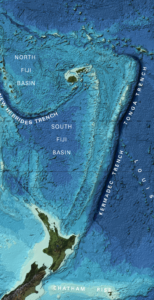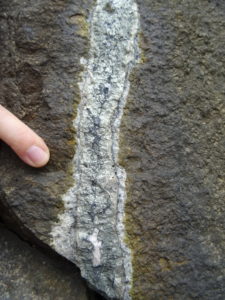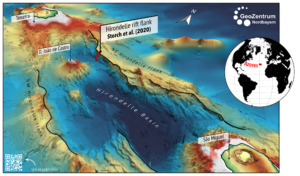Research topics
Formation and evolution of melts in subduction zones
Subduction zones are the geologically most active regions of the Earth with strong earthquakes and explosive volcanic eruptions. This is also where much of the continental crust is formed through processes of melting and crystallization. We investigate how and why melts form at subduction zones and what the effects of subducted material such as sediments is. We also study how magmas change during uplift and what the consequences are for the formation of volcanoes and for the structure of the Earth’s crust.
Our areas of work on this topic are the Aegean Sea and the Tonga-Kermadec and Solomon Islands-Vanuatu subduction zones in the SW Pacific.
- Beier, C., Haase, K.M., Brandl, P.A., and Krumm, S.H., 2017. Primitive andesites from the Taupo Volcanic Zone formed by magma mixing. Contributions to Mineralogy and Petrology 172, doi:10.1007/s00410-017-1354-0.
- Schaarschmidt, A., Klemd, R., Regelous, M., Voudouris, P.C., Melfos, V., and Haase, K.M., 2021. The formation of shoshonitic magma and its connection to porphyry-type mineralisation: the Maronia pluton in NE Greece. Lithos 380-381, 105911, doi: 1016/j.lithos.2020.105911.
- Schoenhofen, M.V., Woelki, D., Haase, K.M., Beier, C., and Regelous, M., 2020. Chemical evolution of calc-alkaline magmas during the ascent through continental crust: constraints from Methana, Aegean arc. Journal of Petrology 61, doi: 1093/petrology/egaa036.
- Woelki, D., Regelous, M., Haase, K.M., Romer, R.H.W., and Beier, C., 2018. Petrogenesis of boninitic lavas from the Troodos Ophiolite, and comparison with Izu-Bonin-Mariana fore-arc crust. Earth and Planetary Science Letters 498, 203-214. doi: 10.1016/j.epsl.2018.06.041
Magmatic and hydrothermal processes of metal enrichment
 The cooling of melts in the earth’s crust leads to the circulation of hot solutions, whereby metals are dissolved and partially precipitated again in the form of ores. Many melts from the Earth’s interior also have dissolved volatile components such as water, carbon dioxide or sulfur, which degas during ascent and thus also mobilize metals. The combination of the various processes leads to the formation of hydrothermal solutions that can chemically alter large areas of the Earth’s crust and precipitate significant concentrations of metals such as copper, molybdenum, or silver as sulfur compounds. We study the magmatic and hydrothermal processes involved in the formation of different types of ore deposits. Our areas of work on this topic are the Aegean Sea and the Tonga-Kermadec and Solomon Islands-Vanuatu subduction zones in the SW Pacific.
The cooling of melts in the earth’s crust leads to the circulation of hot solutions, whereby metals are dissolved and partially precipitated again in the form of ores. Many melts from the Earth’s interior also have dissolved volatile components such as water, carbon dioxide or sulfur, which degas during ascent and thus also mobilize metals. The combination of the various processes leads to the formation of hydrothermal solutions that can chemically alter large areas of the Earth’s crust and precipitate significant concentrations of metals such as copper, molybdenum, or silver as sulfur compounds. We study the magmatic and hydrothermal processes involved in the formation of different types of ore deposits. Our areas of work on this topic are the Aegean Sea and the Tonga-Kermadec and Solomon Islands-Vanuatu subduction zones in the SW Pacific.
Related publications
- Keith, M., Häckel, F., Haase, K.M., Schwarz-Schampera, U., and Klemd, R., 2016. Trace element systematics of pyrite from submarine hydrothermal vents. Ore Geol. Rev., doi: 1016/j.oregeorev.2015.07.012.
- Schmidt, K., Garbe-Schönberg, D., Hannington, M.D., Anderson, M.O., Bühring, B., Haase, K., Haruel, C., Lupton, J.E., Koschinsky, A., 2017. Boiling vapour-type fluids from the Nifonea vent field (New Hebrides Back-Arc, Vanuatu, SW Pacific): Geochemistry of an early-stage, post-eruptive hydrothermal system. Geochimica et Cosmochimica Acta 207, 185-209.
- Falkenberg, J., Keith, M., Haase, K. M., Bach, W., Klemd, R., Strauss, H., Yeo, I. A., Rubin, K. H., Anderson, M. O., 2021. Effect of fluid boiling on volatile element and Au enrichment in submarine hydrothermal sulphides, Niua South, Tonga arc. Geochimica et Cosmochimica Acta, 307, 105-132.
- Keith, M., Smith, D. J., Doyle, K., Holwell, D. A., Jenkin, G. R. T., Barry, T. L., Becker, J., Rampe, J., 2020. Pyrite chemistry: A new window into Au and Te ore-forming processes in alkaline epithermal districts, Cripple Creek, Colorado. Geochimica et Cosmochimica Acta, 274, 172-191.
- Martin, A.J., Keith, M., McDonald, I., Haase, K.M., McFall, K., Klemd, R., and MacLeod, C., 2019. Trace element systematics and ore-forming processes in mafic VMS deposits: Evidence from the Troodos ophiolite, Cyprus. Ore Geology Reviews 106, 205-225. doi: 1016/j.oregeorev.2019.01.24
Magmatic processes in oceanic and continental rifting zones
 Large-scale tectonic processes lead to stretching and thinning of the Earth’s lithospheric plates, so that often melts are formed in the Earth’s mantle and volcanoes occur at both continental and oceanic stretching regions. Stretching causes new lithosphere to form at rates of several centimeters per year at mid-ocean ridges, and the basaltic melts that form here build up the oceanic crust. We study the interplay of tectonic and magmatic processes in the formation of the crust and volcanoes. Our working areas on this topic are the Azores in the oceanic and the Central European Rift System in the continental.
Large-scale tectonic processes lead to stretching and thinning of the Earth’s lithospheric plates, so that often melts are formed in the Earth’s mantle and volcanoes occur at both continental and oceanic stretching regions. Stretching causes new lithosphere to form at rates of several centimeters per year at mid-ocean ridges, and the basaltic melts that form here build up the oceanic crust. We study the interplay of tectonic and magmatic processes in the formation of the crust and volcanoes. Our working areas on this topic are the Azores in the oceanic and the Central European Rift System in the continental.
Related publications
- Regelous, M., Weinzierl, C.G., and Haase, K.M., 2016. Controls on melting at spreading ridges from correlated abyssal peridotite – mid-ocean ridge basalt compositions. Earth and Planetary Science Letters 449, 1-11.
- Haase, K.M., Beier, C., Regelous, M., Rapprich, V., and Renno, A., 2017. Spatial variability of source composition and petrogenesis in rift and rift flank alkaline lavas from the Eger Rift, Central Europe. Chemical Geology 455, 304-314. doi: 1016/j.chemgeo.2016.11.003.
- Romer, R.H.W., Beier, C., Haase, K.M., Klügel, A., and Hamelin A., 2019, Progressive changes in magma transport at the active Serreta Ridge, Azores. Geochemistry, Geophysics, Geosystems 20,5394-5414. Doi: 10.1029/2019GC008562.
- Storch, B., Haase, K.M., Beier, C., Romer, R.H.W., and Koppers, A.A.P., 2020. Rifting of the Azores Plateau by alternating magmatic and tectonic phases. Scientific Reports 10, 19718, doi: 1038/s41598-020-76691-1.

